The Blank Wall is Tired
Sean Scherer’s Authentic Interiors Reject Minimalism as a Habit
By Susan Barnett | Photos by William Abranowicz | Winter 2020 | Design Feature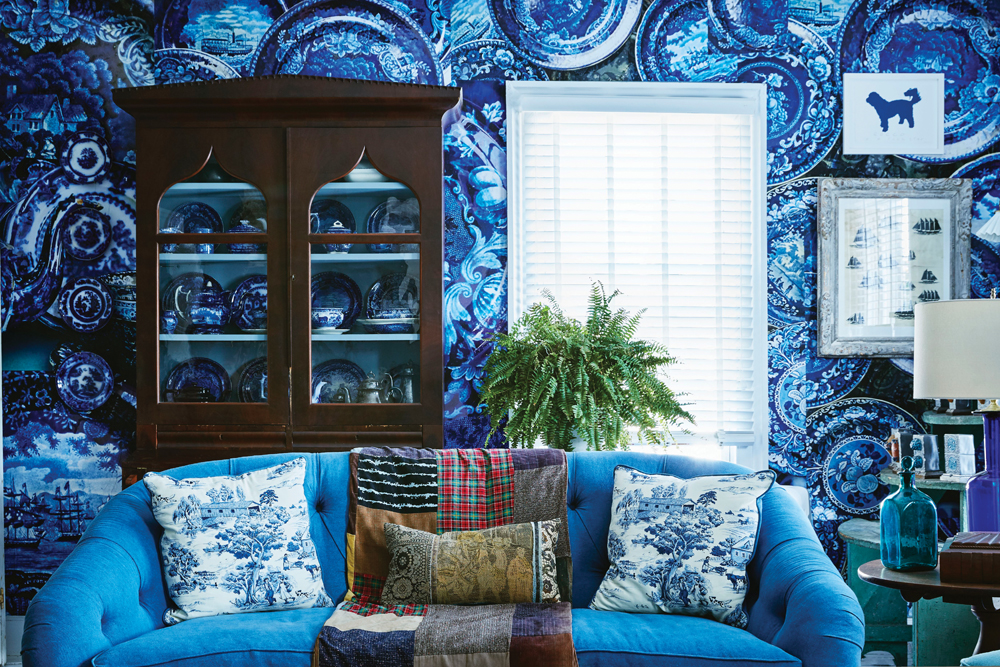
Minimalism may not survive COVID-19. The shutdown has forced us to experience home with striking intensity. An environment of comfort, familiarity, and warmth, is what many of us are now are craving when we look around where we live. Sean Scherer’s Kabinett & Kammer, tucked away in the Catskills village of Franklin, offers just that. (The shop’s name comes from the German words for cabinet and chamber.)
Scherer, a painter who’s shown extensively in the US and Europe, views interior design as an artistic conversation between interesting objects and their space.
Kabinett & Kammer is home to Scherer’s unconstrained visual vocabulary, an ever-changing display of thoughtfully juxtaposed vintage and modern furniture and accessories. Bold floral wallpaper meets a deep yellow, wood-paneled wall. A taxidermy goat head emerges from a wall-mounted floral tray. Arrangements of prints, books, dried flowers, mirrors, old clock faces, baskets, commonplace items displayed in unexpected ways—it’s all part of what becomes, in essence, a still life, a vignette, a series of experiences. “It’s all about making an interior feel naturally layered and acquired over time, with all those imperfections included,” Scherer explains.
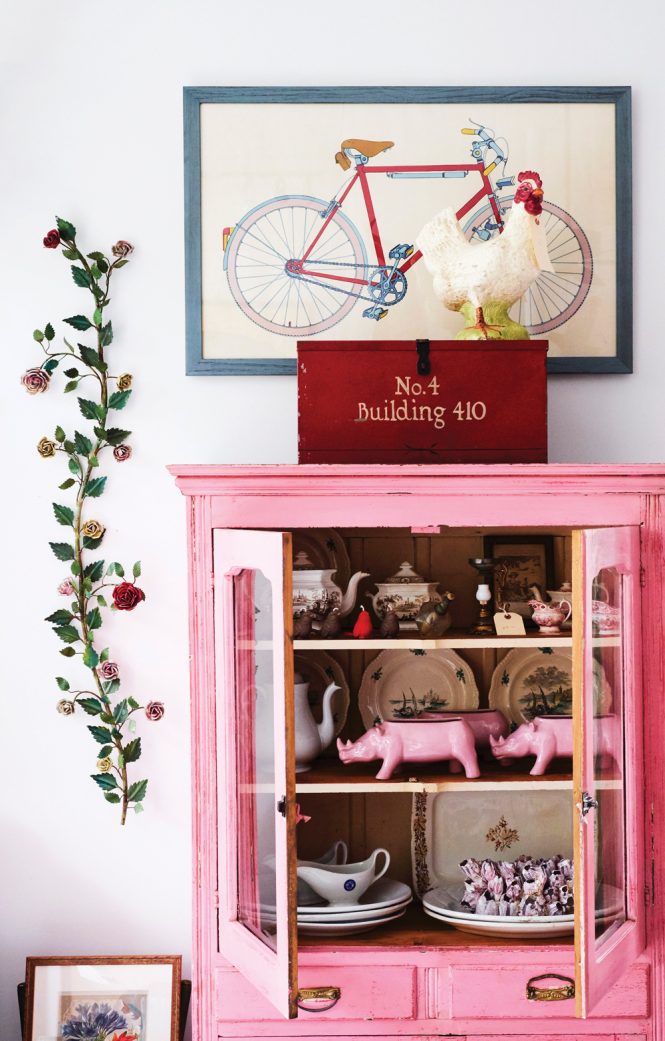
A display in Kabinett & Kammer that combines a cheerful pink cabinet with an Italian tole rose branch, a porcelain chicken, and a bicycle poster.
His designs are a revolt against minimalism as a habit. “What strikes me about the shelter magazine business today,” Scherer says, “is how fake and staged almost all the homes look. They are cold. There’s no realness, no authenticity to these interiors—that blank-wall aesthetic is tired.”
Scherer’s design aesthetic is illustrated in glorious color in Sean Scherer’s Kabinett & Kammer: Creating Authentic Interiors (Vendome Publishing, 2020). And that aesthetic is anything but austere. The use of color is bold. The display of items is dense, and often unexpected. Each page is a feast for the eyes, just as he describes his conception for the shop he opened in 2007 in his new book: “The whole store would be a revolving work of art and would act as a laboratory for my evolving collections and displays. I also wanted to emphasize the modernity of the utilitarian pieces I favored: objects and furniture that people made in their barns for specific purposes and uses. They weren’t intended to be artistic, but simplicity combined with practicality—plus years of use—had transformed them from the ordinary into the extraordinary.”
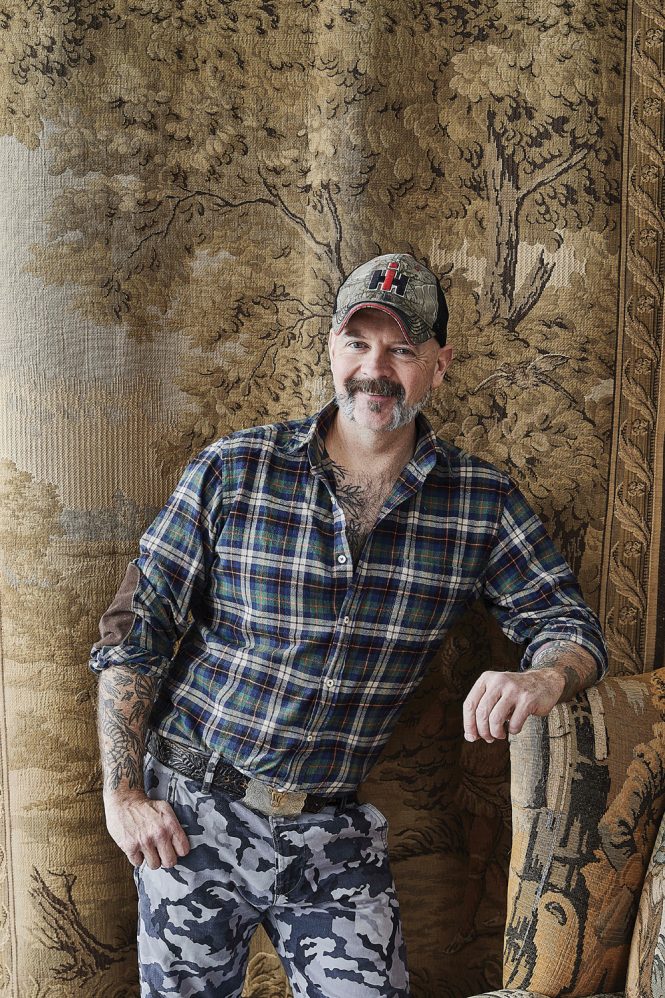
Sean Scherer in Kabinett & Kammer, the design shop he opened in the Catskills in 2007. Scherer’s intention: “The whole store would be a revolving work of art and would act as a laboratory for my evolving collection and displays.”
Artistic Tradition
Scherer has been featured in the New York Times multiple times, as well as House Beautiful, Country Living, and Sweet Paul magazine. He left the city after 9/11, and opened his first shop when a friend offered him storefront space in the Delaware County village of Andes. Two years ago, he moved 20 miles farther north to Franklin.
Wait. Where?
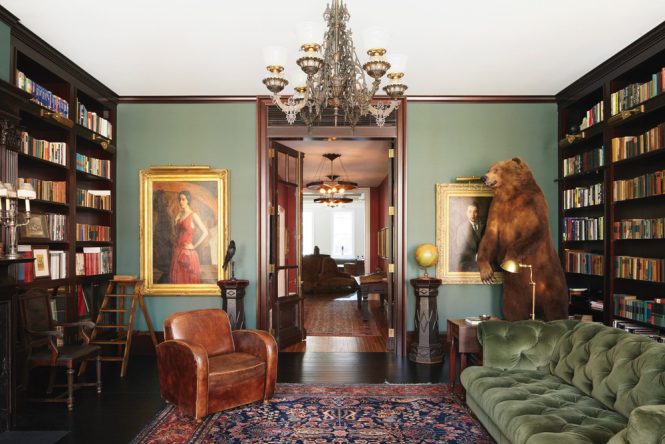
A stately library designed by Scherer combines soothing green tones with a taxidermy bear.
“I’ve always loved Franklin,” Scherer says. “It is one of the most historically intact villages upstate, and one of the best kept secrets in the region.” The Village of Franklin, in fact, is on the National Historic Registry. Its main street is lined with stately white homes and equally stately maple trees.
Franklin has a long artistic tradition. It is home to the Stagecoach Run Art Festival, an annual self-guided tour of local art galleries, and the Franklin Stage, an Actor’s Equity professional theater that hosts productions throughout the summer. At least in normal summers. But Franklin has been relatively off the radar for the new generation of downstate visitors and expats. Until recently.
Scherer and his partner, fashion designer Gary Graham, opened adjoining stores in a building they bought at 422 Main Street. They live in Franklin full time, making their home above the shops. Their living room, and Graham’s studio, are both featured in Scherer’s book.
Scherer, Graham, and Bea’s at 422, a cafe and market that opened in the same building, have all seemed to thrive since their arrival, even in the year of the pandemic. In fact, Scherer said this past summer was one of his best seasons ever. “I think people are not spending as much on travel,” Scherer says. “So, they’re investing in where they live.”
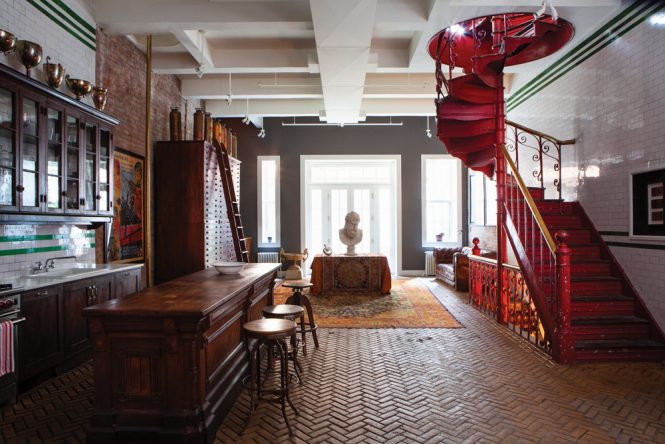
The ground floor of this former firehouse has been transformed into kitchen. A few large pieces, including an antiques store counter that serves as an island and a tall file cabinet add scale and counterbalance the ornate spiral stair.
More is Less
Much of Kabinett & Kammer’s business is internet-based, and Scherer’s new book is adding to his international reputation. “There’s been a fabulous reaction to the book,” he says. “My publisher, Vendome, has ordered another printing just to keep up. It was a number one new release on Amazon in Antiques and Decorative Arts, and number six in Design.”
The book features not only pictures from his shop and home, but photos of interiors he has designed for private clients. The foreword is from one happy celebrity customer, CNN news anchor Anderson Cooper. Cooper’s home is an 8,400-square-foot former firehouse, where Scherer has created a distinctly masculine, clubby vibe. Cooper wrote, in the book’s foreword, that he wanted his home to be “a kind of cabinet of curiosities, like the home of an explorer from the turn of the century, a personal museum full of art and books and objects collected over the years.”
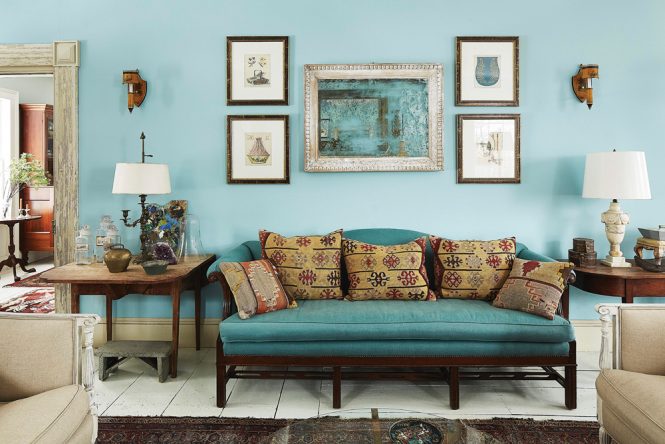
A living room renovation by Scherer: Aqua walls combine with natural materials like raw linen and primitive wood furniture, as well as vintage kilim pillows and rugs, to cozy up the room.
The kitchen features herringbone brick floors, dark vintage wood cabinetry, and, of course, a fire engine red metal staircase. A library has overstuffed chairs, a leather couch, walls of books, and a massive stuffed bear.
Most of his customers, Scherer said, are not interested in the pedigree of an antique. Neither is he.
“It’s about shape and form and how items relate to each other,” he explains. “The antique business has changed. The market is about decorative value, not about whether an item is authentic. It’s a more modern approach.” Yet Scherer has nothing against minimalism. “I love the Shakers,” he said. “And they’re certainly minimalist.”

The ground floor of this former firehouse has been transformed into kitchen. A few large pieces, including an antiques store counter that serves as an island and a tall file cabinet add scale and counterbalance the ornate spiral stair.
5 Design Tips from Sean Scherer
- Buy what you love. It’s been said many times before, but it is so true—if you love it you will find a way to incorporate it in your home.
- Don’t worry about rules: There are none. Have fun in your home. It’s the way to express yourself the most truly.
- Use color. Too much white washes things out and makes for a boring home. It’s amazing how even one accent wall in a bold color can warm a room.
- Mix it up. Play with different textures and shapes and periods. Go for a mood as opposed to a style.
- Think of your home as a story. What narrative are you trying to tell? And what do you want to share with those you invite into your home?
